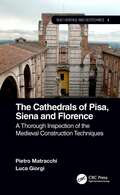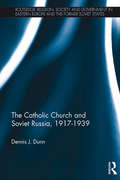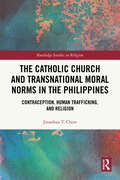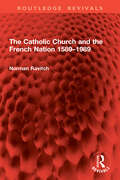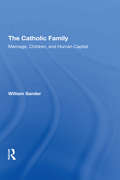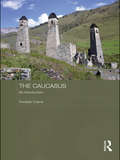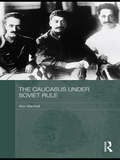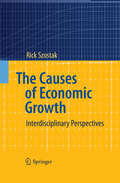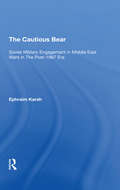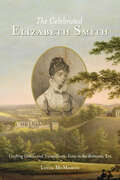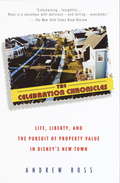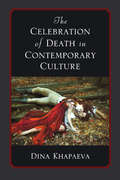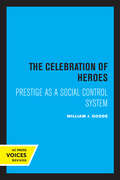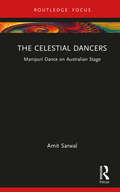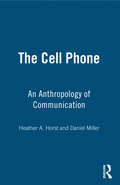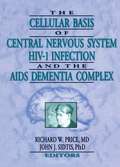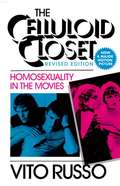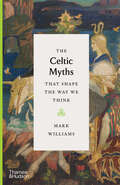- Table View
- List View
The Cathedral Within
by Bill ShoreIn this wise and inspiring book, social entrepreneur Bill Shore shows us how to make the most of life and do something that counts. Like the cathedral builders of an earlier time, the visionaries described in this memoir share a single desire: to create something that endures. The extraordinary people Shore has met on his travels represent a new movement of citizens who are tapping into the vast resources of the private sector to improve public life. Among them are: -- Gary Mulhair, who has created unprecedented jobs and wealth at the largest self-supporting human-service organization of its kind, Pioneer Human Services of Seattle. -- Nancy Carstedt of the Chicago Childrenís Choir, which provides thousands of children their first introduction to music. -- Geoffrey Canada, who has made a safe haven for more than four thousand inner-city children in New York City, from Hell's Kitchen to Harlem. These leaders, and many others described in these pages, have built important new cathedrals within their communities, and by doing so they have transformed lives, including their own.
The Cathedrals of Pisa, Siena and Florence: A Thorough Inspection of the Medieval Construction Techniques (Built Heritage and Geotechnics)
by Pietro Matracchi Luca GiorgiThe construction techniques and concepts of the cathedrals of Pisa, Siena and Florence are examined in detail, based on new data and using a methodological architectural diagnostics approach. New detailed surveys, carried out using often advanced tools, together with direct and in-depth inspections to examine all parts of the buildings, have enabled us to identify the building phases and the different construction techniques used over time. The information thereby acquired also formed the basis for a new interpretation of the archival documents. Accordingly, the problems encountered and the solutions adopted in the three cathedrals have been understood: in Pisa the construction of the elliptical dome above the rectangular crossing consisting of six thin pillars below; in Siena the design changes from the first system in the 13th century to the ‘Duomo Nuovo’, and the structural adaptations following earthquakes; the specific construction solutions adopted in Florence during the instability encountered in the construction of the large vaults of the basilican body. The comparison of the three buildings in terms of architectural and construction solutions also revealed unexpected relationships between the construction events of Siena’s Duomo Nuovo and the solutions then used in the large basilican body of Santa Maria del Fiore. The methodology employed has led to an understanding of the actual structure of the three cathedrals, an essential basis for a correct evaluation of the state of conservation of the churches for any restoration work. The book is aimed at scholars of architecture and ancient building structures, graduate and postgraduate students, and architects and engineers who plan architectural conservation and strengthening works for historical buildings.
The Catholic Church and Liberal Democracy (Routledge Studies in Modern History)
by Bernt Torvild OftestadThe Roman Catholic Church's critical stance towards liberalism and democracy following the French Revolution and through the 19th century was often entrenched, but the Second Vatican Council of the 1960s saw a shift in the Church's attitude towards democracy. In recent years, a conflict has emerged between Church doctrine and modern liberalism under Popes John Paul II and Benedict XVI. This book is a comprehensive overview of the Catholic Church's relationship to modern liberal democracy, from the end of the 18th century until today. It is a connection that is situated within the context of the history of ideas itself.
The Catholic Church and Modern Sexual Knowledge, 1850-1950 (Genders and Sexualities in History)
by Lucia PozziThis book is the first to present a comprehensive historical picture of the modern Catholic concern with the body and sexuality. The Catholic church is commonly believed to have always opposed birth control and abortion throughout the centuries. Yet the Catholic encounter with modern sexuality has a more complex and interesting history. What was the meaning of sexual purity? Why did eugenics matter to Catholicism? How did the Society of Jesus interpret the idea of overpopulation? Why did Pius XI decide to issue the notorious encyclical Casti connubii on Christian marriage – the first modern papal pronouncement on birth control, abortion, and eugenics? In answering these questions, Lucia Pozzi uncovers new archival and unpublished records to dig into Catholic responses to modern sexual knowledge, showing the Catholic church at times resisting, but also often welcoming, scientific modernity.
The Catholic Church and Soviet Russia, 1917-39 (Routledge Religion, Society and Government in Eastern Europe and the Former Soviet States)
by Dennis J. DunnThis book, based on extensive research including in the Russian and Vatican archives, charts the development of relations between the Catholic Church and the Soviet Union from the Bolshevik Revolution of 1917 to the death of Pope Pius XI in 1939. It provides background information on the animosity between the Orthodox and Catholic churches and moves towards reconciliation between them, discusses Soviet initiatives to eradicate religion in the Soviet Union and spread atheist international communism throughout the world, and explores the Catholic Church’s attempts to survive in the face of persecution within the Soviet Union and extend itself. Throughout the book reveals much new detail on the complex interaction between these two opposing bodies and their respective ideologies.
The Catholic Church and Transnational Moral Norms in the Philippines: Contraception, Human Trafficking, and Religion (Routledge Studies in Religion)
by Jonathan T. ChowJonathan T. Chow explores the Roman Catholic Church’s engagement with transnational human rights norms and how its understandings of Catholic identity and doctrine have profoundly shaped the politics surrounding contraception and human trafficking in the Philippines.In the global politics of morality, the Catholic Church is one of the world’s foremost practitioners, shaping not only the language of transnational moral norms but also how they are implemented at the domestic level. Through “norm thickening”—connecting transnational norms to deeply held local identities and religious teachings and institutionalizing those connections in policies, practices, and organizations—the book argues that the Church can build a more coherent and locally credible moral basis for transnational norms than international consensus alone. While in some cases, this can strengthen transnational norms and facilitate cooperation between the Church and the government, in other cases it can instead harden opposition to those norms and facilitate polarization, with significant consequences for Philippine society. Drawing on field interviews in the Philippines, as well as Vatican and UN documents, Chow paints a compelling picture of how one of the world’s largest religions shapes the global moral landscape.This book will be of particular interest to students of religion, Catholic theology, human rights, international relations theory, and Asian studies, and anyone seeking to better understand the transnational politics of morality.
The Catholic Church and the French Nation 1589–1989 (Routledge Revivals)
by Norman Ravitch“Paris is worth a mass” was the realistic response of Protestant Henry IV, who changed his faith to secure the throne of France, to the central importance of the French Catholic Church. Principle and pragmatism have since been, in alteration, the two prime constituents of French Catholicism. In his book The Catholic Church and the French Nation 1589–1989 (originally published in 1990), Norman Ravitch interprets the interaction of the Roman Catholic Church with the national life of France over a period of 400 years. This process, Ravitch argues, has left French Catholicism redundant: more an historical monument than a living institution. This book will be of interest to students and researchers of French history.
The Catholic Family: Marriage, Children, And Human Capital
by William SanderConsidering the effects of a Catholic heritage on families as a whole and on individuals within families, William Sander looks at the patterns of marriage and intermarriage, divorce, and fertility. He then turns to human capital issues, in-eluding the effects of a Catholic background on academic achievement, earnings, employment, and health habits. Examining the effects of Catholic schooling, Sander takes into account the select nature of the Catholic school population and shows that Catholic high schools have a large negative effect on dropout rates but a positive effect on the test scores of African Americans and Hispanics.
The Cattell Controversy: Race, Science, and Ideology
by William H. TuckerRaymond Cattell, the father of personality trait measurement, was one of the most influential psychologists in the twentieth century, with a professional career that spanned almost seventy years. In August 1997, the American Psychological Association announced that Cattell had been selected the recipient of the American Psychological Foundation Gold Medal Award for Life Achievement in Psychological Science. Then, only two days before the scheduled ceremony, the APF abruptly postponed the presentation of the award due to concerns involving Cattell's views on racial segregation and eugenics. In addition to his mainstream research, in his publications Cattell had also posited evolutionary progress as the ultimate goal of human existence and argued that scientific criteria should be used to distinguish "successful" from "failing" racial groups so that the latter might be gradually "phased out" by non-violent methods such as regulation of birth control. The Cattell Controversy discusses the controversy that arose within the field in response to the award's postponement, after which Cattell withdrew his name from consideration for the award but insisted that his position had been distorted by taking statements out of context. Reflecting on these events, William H. Tucker concludes with a discussion of the complex question of whether and how a scientist's ideological views should ever be a relevant factor in determining the value of his or her contributions to the field.
The Caucasus
by James ForsythFor the first time, this major new survey of the Caucasus traces a unified narrative history of this complex and turbulent region at the borderlands of Europe, Asia and the Middle East, from prehistory to the present. For thousands of years the Caucasus has formed the intersection of routes of migration, invasion, trade and culture, and a geographical bridge between Europe and Asia, subject to recurring imperial invasion. Drawing on sources in English, Russian, Persian and Arabic, amongst others, this authoritative study centres on the region's many indigenous peoples, including Abkhazians, Armenians, Azerbaijanis, Chechens and Circassians, and their relations with outsiders who still play an important part in the life of the region today. The book presents a critical view of the historical role of Russian imperialism in events in the Caucasian countries, and the violent struggle of some of these peoples in their efforts to establish a precarious independence.
The Caucasus - An Introduction (Routledge Contemporary Russia and Eastern Europe Series)
by Frederik CoeneThe Caucasus is one of the most complicated regions in the world: with many different peoples and political units, differing religious allegiances, and frequent conflicts, and where historically major world powers have clashed with each other. Until now there has been no single book for those wishing to learn about this complex region. This book fills the gap, providing a clear, comprehensive introduction to the Caucasus, which is suitable for all readers. It covers the geography; the historical development of the region; economics; politics and government; population; religion and society; culture and traditions; alongside its conflicts and international relations. Written throughout in an accessible style, it requires no prior knowledge of the Caucasus. The book will be invaluable for those researching specific issues, as well as for readers needing a thorough introduction to the region.
The Caucasus Under Soviet Rule (Routledge Studies in the History of Russia and Eastern Europe)
by Alex MarshallThe Caucasus is a strategically and economically important region in contemporary global affairs. Western interest in the Caucasus has grown rapidly since 1991, fuelled by the admixture of oil politics, great power rivalry, ethnic separatism and terrorism that characterizes the region. However, until now there has been little understanding of how these issues came to assume the importance they have today. This book argues that understanding the Soviet legacy in the region is critical to analysing both the new states of the Transcaucasus and the autonomous territories of the North Caucasus. It examines the impact of Soviet rule on the Caucasus, focusing in particular on the period from 1917 to 1955. Important questions covered include how the Soviet Union created ‘nations’ out of the diverse peoples of the North Caucasus; the true nature of the 1917 revolution; the role and effects of forced migration in the region; how over time the constituent nationalities of the region came to re-define themselves; and how Islamic radicalism came to assume the importance it continues to hold today. A cauldron of war, revolution, and foreign interventions - from the British and Ottoman Turks to the oil-hungry armies of Hitler’s Third Reich - the Caucasus and the policies and actors it produced (not least Stalin, Sergo Ordzhonikidze and Anastas Mikoyan) both shaped the Soviet experiment in the twentieth century and appear set to continue to shape the geopolitics of the twenty-first. Making unprecedented use of memoirs, archives and published sources, this book is an invaluable aid for scholars, political analysts and journalists alike to understanding one of the most important borderlands of the modern world.
The Causes of Economic Growth
by Rick SzostakWhat are the causes of economic growth? As billions of people still live in poverty, this is perhaps the most important question in human science. It is also a very complex one, as rates of economic growth are influenced by a multitude of economic as well as political, geographical and sociological factors. This books attempts to advance a nuanced understanding of the process of economic growth by synthesizing the insights of several social science disciplines. Different theories and methods employed by economists and other social scientists to study the causes of economic growth are analyzed and it is shown how and why those insights should be integrated by applying best-practice techniques of interdisciplinary analysis. Scholars and practitioners are thus provided with a wide array of potential strategies for encouraging growth as well as guidance on how these strategies may interact.
The Cautious Bear: Soviet Military Engagement In Middle East Wars In The Post-1967 Era
by Efraim KarshThis book analyzes Soviet military engagement in Middle East wars in the post-1967 era. It clarifies the nature and characteristics of this engagement, offers an explanation for its occurrence, and tries to predict future trends.
The Cavalry Maid: The Memoirs of a Woman Soldier of 1812
by Nadezhda DurovaNadezhda Andreyevna Durova, by order of the Emperor Alexander--cornet Alexandrov, Knight of military order. Moved by love of her motherland, she entered the ranks of the Lithuanian Uhlan Regiment. She rescued an officer and was awarded the George Cross. She served 10 years in the regiment, was promoted to cornet and achieved the rank of captain of cavalry. Born 1783. Died 1866. Peace to her ashes! May her valorous spirit serve eternally as an exemplar to posterity.
The Celebrated Elizabeth Smith: Crafting Genius and Transatlantic Fame in the Romantic Era (Jeffersonian America)
by Lucia McMahonElizabeth Smith, a learned British woman born in the momentous year 1776, gained transnational fame posthumously for her extensive intellectual accomplishments, which encompassed astronomy, botany, history, poetry, and language studies. As she navigated her place in the world, Smith made a self-conscious decision to keep her many talents hidden from disapproving critics. Therefore, her rise to fame began only in 1808, when her posthumous memoir appeared. In this elegantly written biography, Lucia McMahon reconstructs the places and social constellations that enabled Smith’s learning and adventures in England, Wales, and Ireland, and traces her transatlantic fame and literary afterlife across Britain and the United States. Through re-telling Elizabeth Smith’s fascinating life story and retracing her posthumous transatlantic fame, McMahon reveals a larger narrative about women’s efforts to enact learned and fulfilling lives, and the cultural reactions such aspirations inspired in the early nineteenth century. Although Smith was cast as "exceptional" by her contemporaries and modern scholars alike, McMahon argues that her scholarly achievements, travel explorations, and posthumous fame were all emblematic of the age in which she lived. Offering insights into Romanticism, picturesque tourism, celebrity culture, and women’s literary productions, McMahon asks the provocative question, "How many seemingly exceptional women must we uncover in the historical record before we are no longer surprised?"
The Celebration Chronicles
by Andrew RossScholar and iconoclast Andrew Ross spent a year living in the much scrutinized, and often demonized, Celebration--the picture-perfect town that Disney is building for 20,000 people in the swamp and scrub of central Florida. Lavishly planned with a downtown center and newly minted antique homes, and front-loaded with an ultraprogressive school, hospital, and high-tech infrastructure, Celebration was to offer a fresh start in a world gone wrong. Yet behind the picket fences, gleaming facades, and "Kodak moment" streetscapes, Ross discovered a real place with real problems, and not a theme park village cooked up by the Imagineers. Compelling and wide-ranging in its analysis, The Celebration Chronicles provides a startlingly fresh perspective on the link between contemporary urban planning and corporate bottom lines.From the Trade Paperback edition.
The Celebration of Death in Contemporary Culture
by Dina KhapaevaThe Celebration of Death in Contemporary Culture investigates the emergence and meaning of the cult of death. Over the last three decades, Halloween has grown to rival Christmas in its popularity. Dark tourism has emerged as a rapidly expanding industry. “Corpse chic” and “skull style” have entered mainstream fashion, while elements of gothic, horror, torture porn, and slasher movies have streamed into more conventional genres. Monsters have become pop culture heroes: vampires, zombies, and serial killers now appeal broadly to audiences of all ages. This book breaks new ground by viewing these phenomena as aspects of a single movement and documenting its development in contemporary Western culture. This book links the mounting demand for images of violent death with dramatic changes in death-related social rituals. It offers a conceptual framework that connects observations of fictional worlds—including The Twilight Saga, The Vampire Diaries, and the Harry Potter series—with real-world sociocultural practices, analyzing the aesthetic, intellectual, and historical underpinnings of the cult of death. It also places the celebration of death in the context of a longstanding critique of humanism and investigates the role played by 20th-century French theory, posthumanism, transhumanism, and the animal rights movement in shaping the current antihumanist atmosphere. This timely, thought-provoking book will appeal to scholars of culture, film, literature, anthropology, and American and Russian studies, as well as general readers seeking to understand a defining phenomenon of our age.
The Celebration of Heroes: Prestige as a Social Control System
by William J. GoodeThis title is part of UC Press's Voices Revived program, which commemorates University of California Press’s mission to seek out and cultivate the brightest minds and give them voice, reach, and impact. Drawing on a backlist dating to 1893, Voices Revived makes high-quality, peer-reviewed scholarship accessible once again using print-on-demand technology. This title was originally published in 1978.
The Celestial Dancers: Manipuri Dance on Australian Stage (Routledge Advances in Theatre & Performance Studies)
by Amit SarwalThe Celestial Dancers: Manipuri Dance on Australian Stage charts the momentous journey of the popularization of Manipur’s Hindu dances in Australia. Tradition has it that the people of Manipur, a northeastern state of India, are descended from the celestial gandharvas, dance and music blessed among them as a God’s gift. The intricately symbolic Hindu dances of Manipur in their original religious forms were virtually unseen and unknown outside India until an Australian impresario, Louise Lightfoot, brought them to the stage in the 1950s. Her experimental changes through a pioneering collaboration with dancers Rajkumar Priyagopal Singh and Ibetombi Devi modernized Manipuri dance for presentation on a global stage. This partnership moved Manipur’s Hindu dances from the sphere of ritualistic temple practice to a formalized stage art abroad. Amit Sarwal chronicles how this movement, as in the case of other prominent Indian classical dances and dancers, enabled both Manipuri dance and dancers to gain recognition worldwide. This book is ideal for anyone with an interest in Hindu temple dance, Manipur dance, cross-cultural collaborations and the globalizing of Indian Classical Dance. The Celestial Dancers is a comprehensive study of how an exceptional Hindu dance form developed on the global stage.
The Cell Phone: An Anthropology of Communication
by Daniel Miller Heather HorstFew modern innovations have spread quite so quickly as the cell phone. This technology has transformed communication throughout the world. Mobile telecommunications have had a dramatic effect in many regions, but perhaps nowhere more than for low-income populations in countries such as Jamaica, where in the last few years many people have moved from no phone to cell phone. This book reveals the central role of communication in helping low-income households cope with poverty. The book traces the impact of the cell phone from personal issues of loneliness and depression to the global concerns of the modern economy and the transnational family. As the technology of social networking, the cell phone has become central to establishing and maintaining relationships in areas from religion to love. The Cell Phone presents the first detailed ethnography of the impact of this new technology through the exploration of the cell phone's role in everyday lives.
The Cellular Basis of Central Nervous System HIV-1 Infection and the AIDS Dementia Complex
by Richard W Price John J SidtisIn this exciting symposium, the editor brings to print important new information on AIDS and how HIV affects the brain. Each chapter focuses on one or more of the cell types that reside in or traffic through the central nervous system (CNS). Each of these cells is important to considerations of the pathogenesis of the CNS. Neurologists, AIDS physicians, and other professionals caring for AIDS patients will find that this “cell-based” view provides a unique perspective and that it will guide and stimulate future investigation of this clinically important and pathogenetically intriguing disorder. The editor also introduces some general considerations for therapeutic intervention of AIDS dementia complex (ADC).The contributors to The Cellular Basis of Central Nervous System HIV-1 Infection and the AIDS Dementia Complex deal with the cells and mechanisms involved in HIV-1 brain infection and the resultant ADC. Each author was asked to review the involvement of their assigned cells in CNS HIV-1 infection and how these cells might be involved in the pathology and process of brain injury associated with ADC. Readers will be enlightened on the functional roles of various cells and how these cells and mechanisms might fit into the broader picture of ADC pathogenesis.
The Celluloid Closet: Homosexuality in the Movies
by Vito RussoPraised by the Chicago Tribune as "an impressive study" and written with incisive wit and searing perception--the definitive, highly acclaimed landmark work on the portrayal of homosexuality in film.
The Celluloid Specimen: Moving Image Research into Animal Life
by Benjamin Schultz-FigueroaA free ebook version of this title is available through Luminos, University of California Press’s Open Access publishing program. Visit www.luminosoa.org to learn more. In The Celluloid Specimen, Benjamín Schultz‑Figueroa examines rarely seen behaviorist films of animal experiments from the 1930s and 1940s. These laboratory recordings—including Robert Yerkes's work with North American primate colonies, Yale University's rat‑based simulations of human society, and B. F. Skinner's promotions for pigeon‑guided missiles—have long been considered passive records of scientific research. In Schultz‑Figueroa's incisive analysis, however, they are revealed to be rich historical, political, and aesthetic texts that played a crucial role in American scientific and cultural history—and remain foundational to contemporary conceptions of species, race, identity, and society.
The Celtic Myths that Shape the Way We Think
by Mark WilliamsA fresh and revealing look at the stories at the heart of Celtic mythology, exploring their cultural impact throughout history up to the present day. The Celtic Myths That Shape the Way We Think explores a fascinating question: how do myths that were deeply embedded in the customs and beliefs of their original culture find themselves retold and reinterpreted across the world, centuries or even millennia later? Focusing on the myths that have had the greatest cultural impact, Mark Williams reveals the lasting influence of Celtic mythology, from medieval literature to the modern fantasy genre. An elegantly written retelling, Williams captures the splendor of the original myths while also delving deeper into the history of their meanings, offering readers an intelligent and engaging take on these powerful stories. Beautiful illustrations of the artworks these myths have inspired over the centuries are presented in a color plates section and in black and white within the text. Ten chapters recount the myths and explore the lasting influence of legendary figures, including King Arthur, the Celtic figure who paradoxically became the archetypal English national hero; the Irish and Scottish hero Finn MacCool, who as “Fingal” caught the imagination of Napoleon Bonaparte, Johann Wolfgang von Goethe, and Felix Mendelssohn; and the Welsh mythical figure Blodeuwedd, magically created from flowers of the oak, who inspired W. B. Yeats. Williams’s mythological expertise and captivating writing style make this volume essential reading for anyone seeking a greater appreciation of the myths that have shaped our artistic and literary canons and continue to inspire today.

